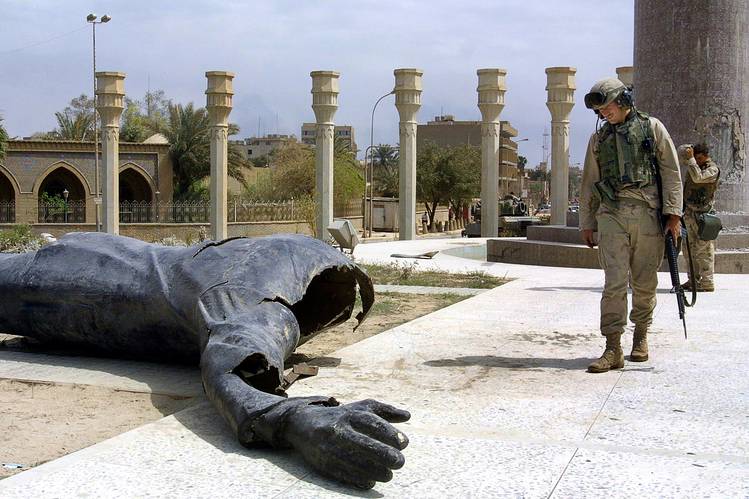By Michael J. Mazarr
 Sixteen years ago this week, the George W. Bush administration sent U.S. forces crashing into Iraq without a real plan for what to do after defeating Saddam Hussein. It is easy to forget that moment’s fervent convictions about the Iraqi dictator’s supposed weapons of mass destruction and links to al Qaeda—and the calamity into which Iraq soon descended. It all seems to belong to another era. The debate today is more about how we got out of Iraq than how we got in.
Sixteen years ago this week, the George W. Bush administration sent U.S. forces crashing into Iraq without a real plan for what to do after defeating Saddam Hussein. It is easy to forget that moment’s fervent convictions about the Iraqi dictator’s supposed weapons of mass destruction and links to al Qaeda—and the calamity into which Iraq soon descended. It all seems to belong to another era. The debate today is more about how we got out of Iraq than how we got in.
The idea that the U.S. would do anything like Iraq again feels ridiculous. We appear to have learned our lesson, and America’s political climate hardly seems primed for new military adventures. No imminent threat demands a response. President Donald Trump arrived in office determined to reduce U.S. commitments abroad, not to multiply them. He is aiming for a deal with North Korea, not war; pulling troops out of Syria and Afghanistan, not pushing more in.
But this picture bears a striking resemblance to the situation in the U.S. in the late 1990s. It was a time of domestic focus. Foreign policy had receded into the background, and no one was clamoring to invade and occupy far-off lands. In the charged atmosphere after 9/11, however, the national mood shifted dramatically. Looking back on the Iraq invasion, a key lesson is how easy it can be to tumble into a war that once seemed preposterous.
In fact, the U.S. could find itself drawn more deeply into any number of armed conflicts today. Before President Trump’s two summits with Kim Jong Un, the administration talked of preventive strikes on North Korean nuclear facilities. The president said last month that “all options are on the table” for the crisis in Venezuela. He also has taken a tough posture toward Iran, while confronting Russian and Chinese forces from the Black Sea to the Spratly Islands. Simmering conflicts in Ukraine and Syria could escalate at any moment.
A specific combination of factors can swiftly transform the prospect of military action from absurd scheme to imminent reality.
It does seem far-fetched that the U.S. would go to war in any of these cases. Americans don’t want their troops rushing to fight in North Korea or Iran; no vital U.S. interests are at stake in Syria or Venezuela. But as late as 2000, no one—not even the most ardent anti-Saddam hawks—was talking about a U.S. invasion of Iraq either. That experience suggests a specific combination of factors that can swiftly transform the prospect of military action from an absurd scheme to an imminent reality.
Such an about-face doesn’t require a commander in chief bent on war. George W. Bush didn’t yearn to be a war president. During the 2000 campaign, he heaped scorn on many of the Clinton administration’s foreign interventions, saying he worried that his Democratic rival, Vice President Al Gore, “uses nation-building and the military in the same sentence.”
The Texas governor promised a “humble” foreign policy, built on strength but also on restraint. Support for U.S. engagement “does not mean our military is the answer to every difficult foreign policy situation,” Mr. Bush argued in a speech at the Ronald Reagan Presidential Library. “American internationalism should not mean action without vision, activity without priority, and missions without end—an approach that squanders American will and drains American energy.”
As president, however, Mr. Bush would order the two most ambitious nation-building projects in U.S. history—in Afghanistan and Iraq—while overextending American power to disastrous lengths.
Mr. Bush was hardly the first president to plunge into military adventures that he had once spurned. Lyndon Johnson worried that tragedy awaited him in Vietnam. As late as 1964, he was still brushing off suggestions that he should send large numbers of U.S. troops to take over the war. Three years later, more than a half million Americans were in Vietnam.

U.S. Marines walk past a famously dismantled statue of Saddam Hussein on Baghdad’s Firdos Square on April 10, 2003.
How can resistance to military adventures disappear so quickly? The cocktail that fuels such transformations typically has three ingredients—and all are very much present in the Trump era.
The first is some big idea steering U.S. foreign policy. In Iraq, it was the post-9/11 marriage of liberal and conservative interventionism, inspired by hawkish conceptions of a missionary role for the U.S. The country was swayed by the idea that America had the right and the responsibility to extinguish threats to peace and liberty everywhere.
The second ingredient is a perceived imperative to act, often in response to a crisis or escalating threat, typically with moralistic overtones. This transforms the big idea from a broad and nebulous concept into a burning priority that demands swift (and often belligerent) action. Decision makers intoxicated by such an imperative tend to disregard consequences: When fulfilling a moral obligation, it seems wrong—even sacrilegious—to fret about potential costs.
In Iraq, the imperative to act grew out of what senior Bush officials saw as an unholy marriage of terrorism and weapons of mass destruction, a union that couldn’t be tolerated in our new age of catastrophic terror. We now know that the evidence for that link was mostly baseless. At the time, it was honestly believed by a strikingly wide swath of Washington policy makers.
No comments:
Post a Comment